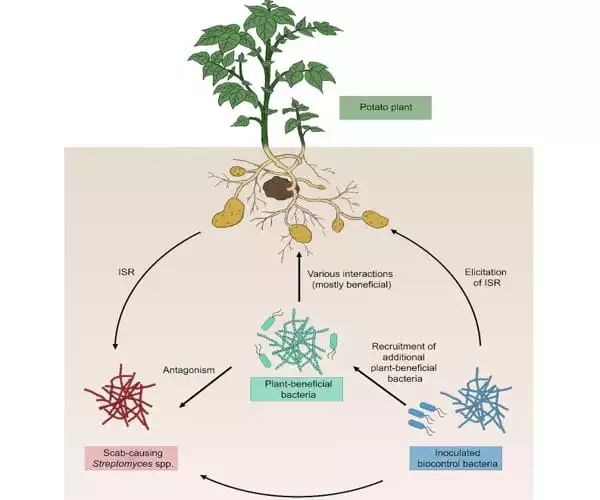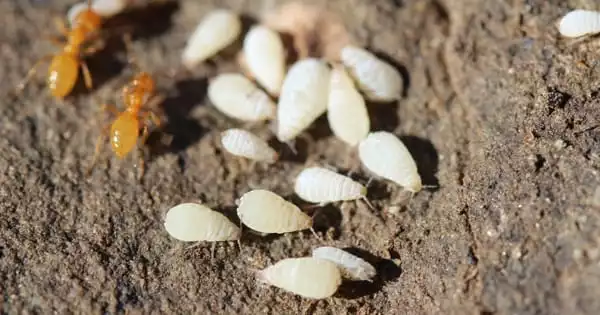A research-industry partnership has resulted in a novel approach of managing a variety of destructive crop diseases utilizing native, beneficial soil microorganisms. The agri-tech breakthrough aims to provide farmers with a method to reduce the cost and environmental damage caused by chemical treatments now used to control crop diseases.
The John Innes Centre researchers extracted and analyzed hundreds of Pseudomonas bacteria strains from a commercial potato field’s soil before sequencing the genomes of 69 of these strains. The researchers was able to uncover a fundamental mechanism in some of the strains that protected the potato crop from hazardous disease-causing bacteria by comparing the genomes of those strains demonstrated to decrease pathogen activity with those that did not.
The researchers then demonstrated, using a mix of chemistry, genetics, and plant infection tests, that the creation of tiny molecules known as cyclic lipopeptides is vital in the management of potato scab, a bacterial disease that causes significant losses in potato harvests.
These tiny compounds have an antibiotic impact on the pathogenic bacteria that cause potato scab, and they aid in the movement and colonization of the plant roots by the protective Pseudomonas. The experiments also revealed that irrigation has a significant impact on the genetically diverse Pseudomonas population in the soil.
The huge advantage of this strategy is that we are employing bacterial strains extracted from the environment and reintroduced in bigger numbers into the same exact biological setting, so there is no ecological impact.
Dr. Alba Pacheco-Moreno
Dr. Alba Pacheco-Moreno, the study’s first author, stated, “By finding and validating processes of potato pathogen suppression, we expect that our work can hasten the development of biological control agents to reduce the need of environmentally hazardous chemical treatments.”
“Because it is based on understanding the mechanisms of action that are critical for biological control agents,” she noted, “the technique we describe should be relevant to a wide spectrum of plant diseases.”
The work, published in eLife, presents a way for researchers to screen the microbiome of almost any agricultural location while accounting for variable soil, agronomic, and climatic circumstances. The approach can scan the soil microbiome for therapeutic bacteria and determine which chemicals are created to decrease pathogenic bacteria by leveraging breakthroughs in high-speed genetic sequencing.
They can also demonstrate how agronomic elements such as soil type and irrigation affect these beneficial bugs. The next step in the new technique is to reintroduce the beneficial bugs into the same field in bigger numbers or in mixed strain cocktails as a soil microbiome enhancing treatment.

Dr. Jacob Malone, Group Leader at the John Innes Centre and co-corresponding author of the paper, outlines the advantages. “The huge advantage of this strategy is that we are employing bacterial strains extracted from the environment and reintroduced in bigger numbers into the same exact biological setting, so there is no ecological impact.”
The bacterial concoctions could be applied as seed coatings, sprays, or drip irrigation. Dr. Andrew Truman, Group Leader at the John Innes Centre and corresponding author of the paper, informs us about the method’s long-term prospects “In the future, we will employ the Pseudomonas strain itself rather than the chemical produced by the bacterium. It provides a more sustainable path because we know these bacteria populate the soil where potatoes grow and protect the crop. You can easily grow and construct a bacterium in a suitable manner and apply it to the field, and it is far greener than using a synthetic chemical.”
Plant infections are an important agricultural issue that cause significant crop losses, such as potatoes. Streptomyces scabies, a bacterial pathogen that produces potato scab, and Phytophthora infestans, an oomycete disease that causes potato blight and was a significant cause of the Great Famine in Ireland, are both important potato pathogens.
Pseudomonas bacteria are typically linked with plants and have been extensively researched as biological control agents because they emit natural compounds that enhance plant growth while suppressing diseases. However, their usage has been limited in the past by inconsistency.
Previous research on the reduction of potato scab has suggested that Pseudomonas could have a biocontrol role. However, development was stymied by a lack of mechanistic understanding. Irrigation has long been recognized to reduce Streptomyces scabies infection, and this study implies that this is due to the effect water has on microbial communities.





